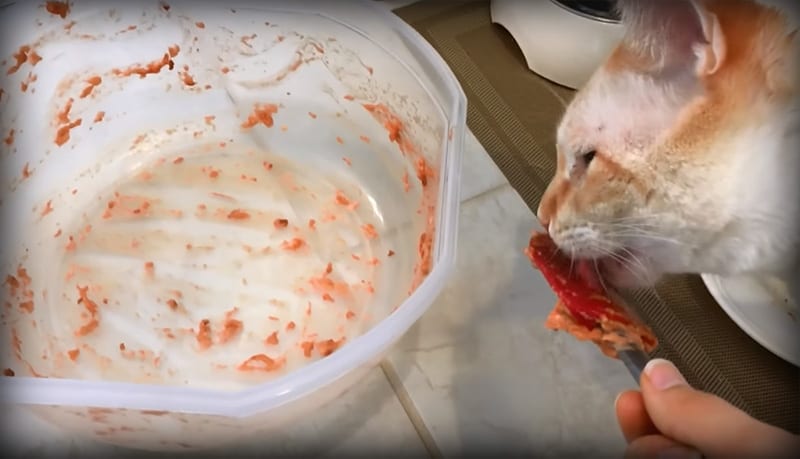Best Homemade Cat Food
There are so many brands of cat food on the market – wet food served in tins, wet food served in trays, dry food in huge sacks that you can decant as and when you need it. From AvoDerm through to Ziwi Pets there’s an A-Z of cat food manufacturers out there all waiting to show you their wares.
But what if you want something a little different for you moggy? Something that takes you away from the processed food and pre-prepared packs, what about if you have a hankering to go au natural and make your own cat food?
Contents
- Why Would I Consider Making My Own Cat Food?
- What Are the Pros and Cons of Making My Own Cat Food?
- How Do I Meet the Dietary Needs of My Cat?
- What Ingredients Should I Include in Home-made Cat Food?
- Raw Cat Food VS Cooked Cat Food
- Raw Food Recipes
- Cooked Food Recipes
- What Shouldn’t I Feed My Cat?
- What Should I Do If My Cat Eats Something He Shouldn’t?
- My Cat Has Kidney Problems – Can I Give Him Home-made Cat Food?
- My Cat Is Prone to Urinary Issues – Can I Give Him Home-made Cat Food?
Why Would I Consider Making My Own Cat Food?
Why bother going to the trouble of researching tasty recipes and sourcing good quality ingredients? Why spend extra time in the kitchen mixing and cooking up appetising food for your moggy when you could just whizz down to your nearest store and grab a 12-pack of meaty chunks in jelly? We’ll tell you why, because somewhere in the back of your head you have a niggling feeling that made from scratch is best.
Take human food, after a busy day at work you get home and stare blankly in the fridge. There’s plenty of fresh food but you’re tired and your brain just can’t figure out what you can make, all you really want is a cuppa and a chocolate biscuit, but you reason with yourself it’s important to eat something proper. You heat up a ready meal, just for speed, but you know deep down a mushroom risotto made by your fair self would have tasted so much better than the bland version before you that’s just escaped from the microwave. It would also contain more in the way of nutrients and the goodness your body craves.
The same goes for the food you serve to your cat. Canned or dried is quicker and no doubt more convenient, but is it as delicious? Does it contain the same natural goodness you would get from home-made? Consider all of the things that go into shop brought ready meals, you will often find artificial elements, preservatives and colorings. You can’t be sure exactly what ingredients are going into your pet’s bowl.
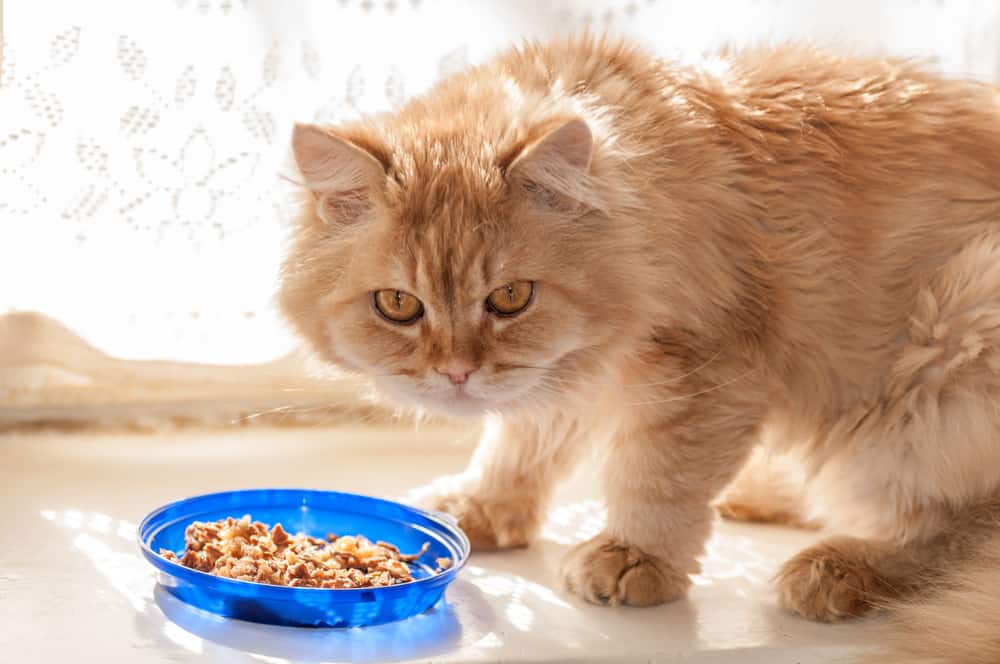
What Are the Pros and Cons of Making My Own Cat Food?
If you decide to try your hand at producing your own cat food for your fluffy companion you should consider the following:
The Cons
1. Quality control needs to be tip-top (as with any other production process). There are risks associated with bacterial contamination – you need to make sure your food prep area is clean.
2. Commercial cans and pouches are designed to keep cat food fresh, you don’t have access to these so you need to carefully consider how you will store your cat food. Incorrectly stored food could make your cat fall ill.
3. Producing your own cat food can be an exacting business, you will need time and patience if you want to make sure your home-made cat food is tip-top.
4. You have to be fastidious in your approach. Commercially manufactured cat food is produced to meet the nutritional needs of your cat, you need to make sure your kitty gets all the goodness he needs from your own home-made version – you need to get the right balance of ingredients and ensure there are plenty of vitamins and minerals etc.
5. Cats are carnivores, they need animal protein. If you are a committed vegetarian or vegan you may find it uncomfortable to handle and prepare meat.
The Pros
1. Producing your own cat food allows you to have complete control over the ingredients
2. You also have control over the production process, you know where your cat food has been made, by whom (you)! Where is has been stored and how long it’s been sitting there.
3. If your cat suffers from health issues such as diabetes or inflammatory bowel disease (both health issues that can be exacerbated by diet) you can alleviate their symptoms by producing cat food to suit them.
4. If your kitty is on the chubby side you can control the ingredients and look into leaner recipes for weight management.
5. You can take pride in becoming your cats very own personal chef – he will love you for it!
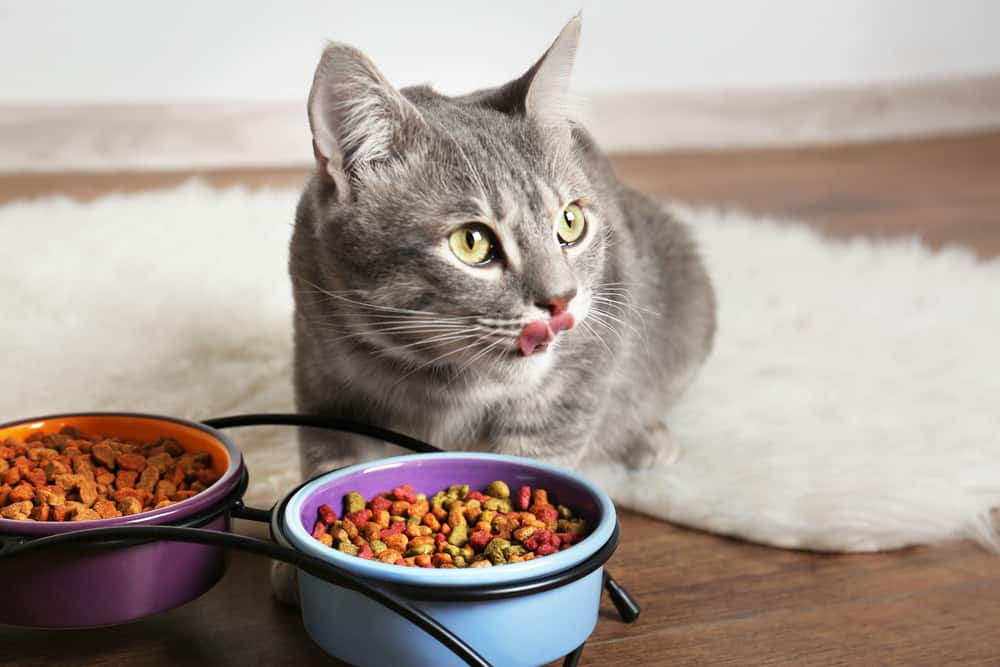
How Do I Meet the Dietary Needs of My Cat?
Cats have a set of dietary needs that should be met from the food they consume, as a rule of thumb your cat needs the following:
- Protein (from meat or fish).
- Amino acids like taurine and arginine (from meat or fish).
- Fatty acids.
- Vitamins.
- Minerals.
- Carbohydrates, not necessarily in large quantities but small amounts will give your puss an energy boost and will help you to bulk out your cat food a little (carbs like rice and corn are cheap and cheerful).
- Water
What Ingredients Should I Include in Home-made Cat Food?
So, what exactly should you feed your little predator? Here are a few fundamental ingredients to consider:
Meat
“I want to be a vegetarian,” said no cat ever (if cats could talk that is)! Despite his fluffiness and ability to give you plenty of love, you should keep in mind that kitty is part of the Felidae family (which includes cheetahs, leopards, and tigers, to name but a few). Carnivore’s by nature, cats aren’t going to be satisfied by flora and fauna, it’s natural, tasty meat for these guys.
As a general rule puss should be eating around 60-80% of meat (this ensures he gets enough protein and amino acids) a few of the most important are taurine, lysine, arginine and cysteine.
Bones
Bones offer a good source of calcium and minerals – grinding up bones doesn’t sound much fun, but if kitty needs it, then it has to be done! If you really can’t face grinding bones then you need to add a calcium supplement.
Organs
Internal organs are a fabulous source of amino acids, and water. Not the nicest thing to be handling – but again if you are venturing down the home-made route you need to roll up your sleeves and get stuck in.
Supplements
Commercially produced cat food contains all of the necessary vitamins and minerals your puss needs. However, if you are making your own cat food you need to work out what should be added to make sure kitty gets his daily quota of goodness. There are premixes available, which are great if your pet is a fussy eater and won’t eat a wide variety of lovingly prepared home-made grub. If you want to look at premixes make sure you check that they have been formulated especially with home-made cat food in mind.
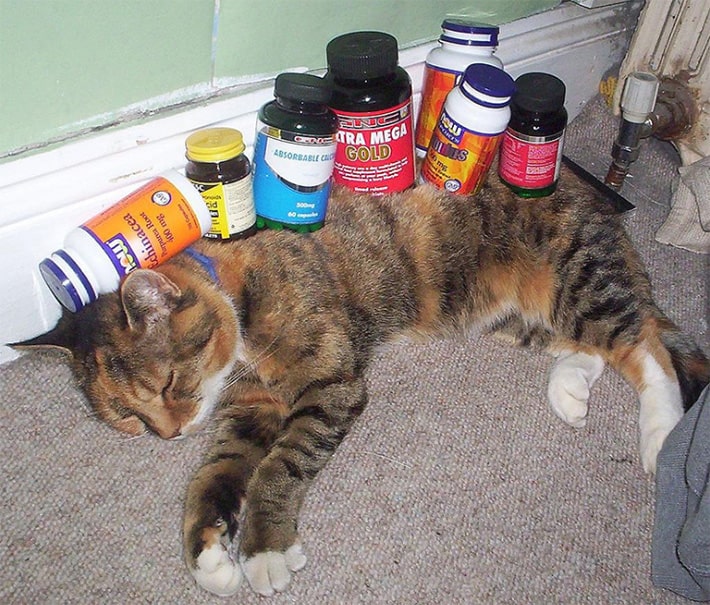
You don’t need a degree in nutrition to figure out what your cat needs, check out your ingredients and go from there. Certain ingredients provide vitamins and minerals naturally, for example beef is a great source of vitamin B12, protein, niacin, vitamin B6, selenium, zinc and phosphorus. It is also a good source of choline, pantothenic acid, iron, potassium and vitamin B2.
If you are planning on trying to feed your cat a whole prey diet (no ground meat, just pure, raw animal protein, along with bones and organs), then you won’t need to add supplements. This is the sort of diet animals in the wild would follow and the carnivorous domestic cat would happily go along with this. However, a whole prey diet isn’t for everyone (certainly not for the squeamish or those without the time and patience)!
If you are not going for the whole-prey approach it’s suggested that you consider adding taurine and liver to your dish, these provide a healthy boost for your moggy.
A word of warning – don’t go vitamin crazy! Avoid adding concentrated vitamins like fat-soluble vitamin A and D, over-supplementing food can be worse than under-supplementing it!
Raw Cat Food VS Cooked Cat Food
There has been much debate on the merits of raw cat food over cooked and vice versa. Let’s compare the two and check out the pros and cons of a raw and cooked cat food diet:
Raw Food Diet – The Cons
- Some argue that a raw food diet alone does not provide all of the nutrients that your cat needs.
- Risk of salmonella poisoning – and this cannot only affect your puss but also humans in the household.
- Risk of zoonotic disease (diseases that can be passed from animals to humans).
- Raw food does not last well – leaving puss for the day? You put the food down at 6am but you have no idea when he will actually eat it.
- You are solely responsible for the quality of the food – you need to find out about the place you are sourcing your raw meat.
- You need to be careful and meticulous, poor ingredients and unhygienic prep can lead to bacterial contamination.
Raw Food Diet – The Pros
- You source the ingredients – so you know where the meat comes from (and can check the quality of it for yourself).
- You are in charge of all food prep – you can make sure you are working in hygienic conditions and complete processes (such as grinding), adequately.
- You can add the essential vitamins and minerals that your moggy needs e.g. taurine.
- Raw home-made food is generally cheaper than store-bought tinned food.
- It doesn’t take as long as you think to knock up your own batch of raw cat food!
- Your puss has sharp, pointy teeth – made to tear through raw meat. A raw diet not only fulfils your cat’s basic instincts but also helps to keep those teeth healthy.
Cooked Food Diet – The Cons
- It can be difficult to work out if you are including the right balance and amount of nutrients in your cat food.
- The Association of Animal Feed Control Officials (AAFCO) recommend commercial cat food as it’s “complete and balanced” – you can’t guarantee your home-made version will be!
- Commercial food has to meet certain standards in line with food safety, if you are cooking at home can you be sure your food is being produced in line with this?
- Who wants to spend even more time in the kitchen? What with the breakfast rush, packed lunches and a family meal to sort out every night how can there be any time left to make meals for a moggy?
Cooked Food Diet – The Pros
- You don’t have to worry about melamine poisoning (which has been linked to commercial cat food in the past).
- You also don’t have to concern yourself with pet-food recalls (it can be a worry when there’s a recall on cat food you’ve purchased and already fed your pet).
- Fresh is considered best for humans, so why not for our beloved pets too? If we are prepping and cooking anyway why should our smallest and fluffiest family member miss out?
- Forge a stronger bond with your cat. You can hand on heart say that you are doing the very best for your cat, if you are making your own food you will research more about felines and come to understand your cat’s likes and dislikes.
Raw Food Recipes
You don’t even have to switch on your cooker for raw food, you just need to measure out your ingredients, mix well and make sure you store in airtight containers in the fridge.
Raw Cat Food Recipes
Mackerel Recipe
For this simple raw mackerel recipe you will need:
- cup of mackerel (tinned is fine).
- 1 tbsp sunflower oil.
- 1 tbsp cooked brown rice.
- 1 or 2 tbsp broth (chicken or broth).
Got everything ready? Great then get out your food blender and give everything a quick whizz. You can serve some to your hungry puss straight away and store the rest in the fridge for him to enjoy over the next couple of days.
Raw Chicken Recipe
This raw chicken cat food recipe has added goodness in the form of taurine and vitamin E. You will need:
- 2 kg ground chicken (this can include bones, meat, etc).
- 200 g pureed chicken liver.
- 4 egg yolks – whisked
- 4 g iodized salt
- 4000 mg salmon oil or fish oil (you can empty from capsules)
- 4000 mg taurine (you can empty from capsules)
- 400 IU Vitamin E
Once you have everything you need mix well and divide into portions. You can then freeze until needed (thaw in fridge overnight before serving)
Cooked Food Recipes
You don’t need to be a Michelin-starred chef to whip up your own cat food, but you do need patience and the desire to provide your pet with healthy, wholesome grub.
Basic Cooked Cat Food Recipe:
Here’s a great example of a simple cooked cat food recipe to set you on your way (this recipe will give you enough for around a day). Check if your cat likes it and if he does you can prepare ahead to store in fridge. You will need:
- ¼ tsp olive oil
- 7 g vitamin / mineral supplement suitable for kitty.
- 30 g cooked potato (remove any skin).
- 50g carbs (such as rice, oatmeal, cooked pasta etc).
- 83g animal protein (such as tuna, salmon, rabbit, chicken, lamb etc)
Once you have all ingredients required simply blend and spoon delicately into kitty’s bowl (or stick it in the fridge for later)!
Fishy Cat Food
This is a great cooked cat food recipe for fish-loving felines, you will need:
- 1 tsp butter
2 cans sardines - ½ cup water
- ½ cup cooked and chopped carrots.
½ cup cooked and chopped green beans. - 1 tsp fish sauce.
First off pop your butter into a pan and warm on a medium heat. Then add your sardines and gently cook for a couple of minutes. Use a spoon to gently smash the sardines, adding the carrots, beans and fish sauce. Bring everything to the boil before removing from heat. Voila, tasty cat food for your puss, just leave it to cool down and serve.
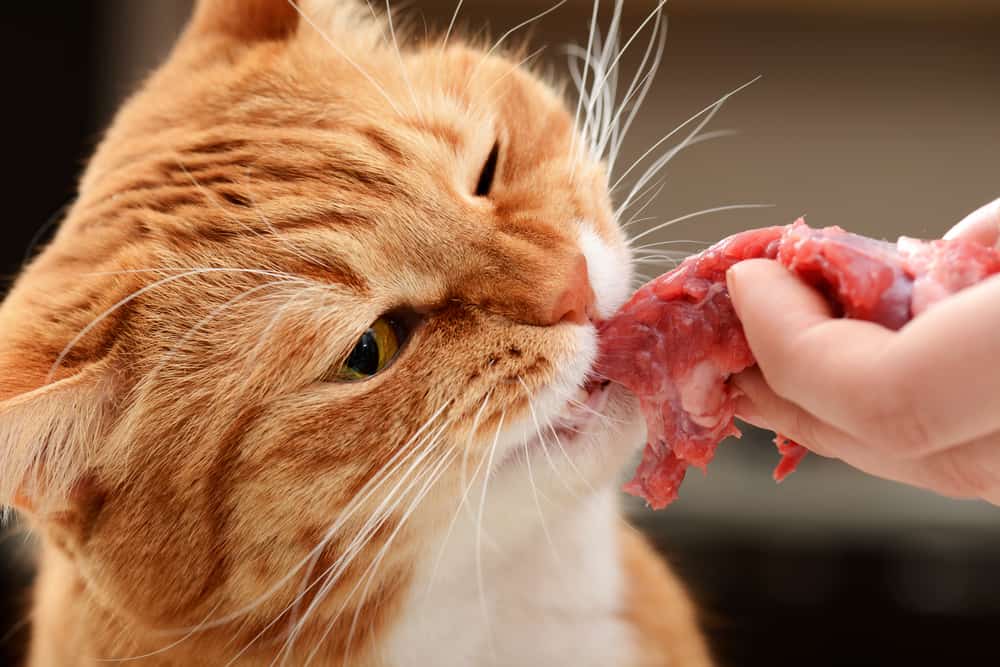
What Shouldn’t I Feed My Cat?
There are some human foods that cats find delectable, but others just aren’t appropriate for puss. Certain food can play havoc with your cat’s digestive system and can lead to sickness, diarrhoea and may put him off eating.
- Chocolate can cause seizures and muscle tremors; you kitty could even suffer from heart problems due to eating it.
- Tea and coffee will make your feline twitchy, speed up his breathing and can cause heart palpitations. Caffeine is no good for our fluffy friends!
- Grapes and their shrivelled twins (raisins) are considered by many to be toxic for felines.
- Garlic and onions can be problematic for felines, they aren’t easily digested and eating too much has even been linked to anaemia.
- Alcohol – this should be common sense to all responsible feline owners but allow us to re-iterate – your fluffy companion does not need to join you in a relaxing end-of-day tipple! Alcohol can cause brain and liver damage, so pour your cat a cool bowl of water instead.
Cats are notorious for being exceptionally curious, they like to explore and if they come across an interesting (and tasty morsel) whilst browsing your kitchen they will probably take a nibble. The best way to prevent your cat from being a bit cheeky on the food front (and prevent him from putting himself in harms way) is to keep potentially dangerous foods stowed away.
What Should I Do If My Cat Eats Something He Shouldn’t?
Think Mr Fluffy has been munching something he shouldn’t be? Don’t panic! The first thing you should do is try and work out exactly what he’s had and how much. It’s always best to seek expert advice (for your pet’s welfare and your own piece of mind). Contact your vet and explain the situation, treatment will be dependent on whether your cat has gnawed at the merest corner or chewed and chomped loads of the stuff.
My Cat Has Kidney Problems – Can I Give Him Home-made Cat Food?
Kidney disease can be caused by numerous things including tumors, toxins and infection. The Kidneys play a pivotal role within the body – cleaning the blood, without the kidneys doing their job the blood becomes awash with waste and this can cause your cat to drink more, urinate more frequently, feel less hungry, appear very tired, lose weight and suffer from sickness.
You might spot these symptoms, but sometimes kidney disease can be present without these tell-tale signs.
Diet can be key in the fight against feline kidney problems, removing toxins – such as preservatives and chemicals, from the diet can really help. Meat should be lean (fatty meat is a no-no), lean chicken and fish are a good choice. You can add oil for a healthy boost (this will help reduce inflammation and increase your cat’s immunity).
Flax oils and fish oils are both an excellent choice. If your cat is a picky eater you need to encourage him to eat, you could try warming his food slightly (this will make it tastier). Cat’s with kidney problems also benefit from taking in extra fluids, water with added broth and the juice from tuna or salmon can be a real treat.
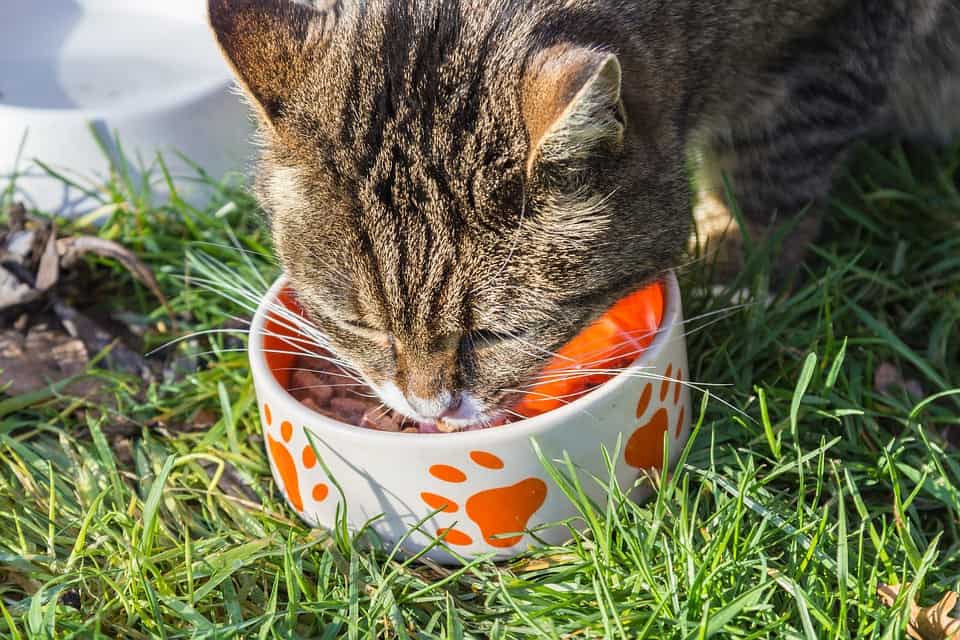
My Cat Is Prone to Urinary Issues – Can I Give Him Home-made Cat Food?
Cats find urinary problems very uncomfortable, but it can be tricky to spot if your cat is suffering from an infection. There are a few signs you can look out for, is your cat urinating more frequently (and in small amounts)? Does he have blood in his urine? Is he straining to pass urine? Or maybe he is looking for alternative places to relieve himself (as he now associates the litter tray with an unpleasant sensation)!
Commercial food can contain lots of carbs and grain (which leads to kitty’s urine becoming more alkaline than acid), in turn this could put your puss at risk of infection. If you want to minimise the risk it seems that meat is the best way to go. Animal protein lowers the PH levels encouraging acidity in the urine – and less chance of contracting a urine infection.
Homemade Cat Food – The Verdict.
Just like you, your cat is interested in what’s on his plate (or in this case in his bowl). Make sure you feed your cat the right amount – a fat cat is prone to health issues. Now it’s up to you whether the cat food you select to serve up is brought from a store or made by your own busy hands. Either way it’s important to ensure the cat food is of good quality, stored correctly and is suited to the needs of your kitty.
Let’s summarise the facts:
- If you go for commercial cat food there’s a huge amount of choice – don’t be afraid to research brands and check out ingredients and labels.
- If you are considering homemade you will need to decide on a cooked or raw diet (or a mix of the two).
- Homemade food takes more time and effort to prepare and produce, but you do choose ingredients for yourself and you know exactly how the food was made (plus it can be cheaper).
- Commercially produced cat food is made in-line with nutritional needs of a cat, it’s difficult to ensure kitty is getting the same level of goodness from homemade food.
- If your cat has health problems you can source food specifically tailored to his needs – whether you make your own or buy from a store.
- Don’t be surprised if you find you have a pernickety puss! Cats have a delectable pallet and what is enjoyed by one might be hated by another.
There are pros and cons for serving up commercial and homemade food, the crux of the matter is: you need to choose which type of food is best based upon your own limitations (time etc) and the needs and preferences of your cat.
Whether you choose commercial or home-made cat food it’s important that you provide a balanced diet that offers all the required nutrients. Your pampered puss deserves (and expects) the very best – make sure you deliver!

